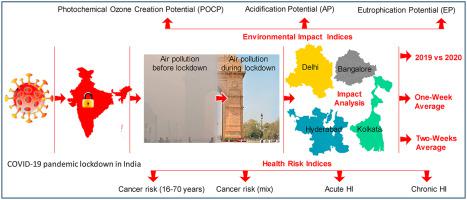Environmental Research ( IF 8.3 ) Pub Date : 2021-02-26 , DOI: 10.1016/j.envres.2021.110932 Selvaraj Ambika , Umesh Basappa , Ananya Singh , Vijaya Gonugade , Rajveer Tholiya

|
Coronavirus disease (COVID-19) spread across the globe through the human transmission. The World Health Organization suggested social distancing to curb the community spread. After national social lockdown started in India, air quality improved drastically. This further hypothesized to influence the environment and human health, and this study is positively the first to weigh it using multiple indices. The calculated environmental indices are photochemical ozone creation potential (POCP), acidification potential (AP), and eutrophication potential (EP). The cancer risk, chronic health index (CHI), and acute health index (AHI) were considered to calculate the health risk. The spatial trend change in the air pollution reflecting on these indices are calculated for four Indian megacities Delhi, Bangalore, Hyderabad, and Kolkata. Temporal variation was accounted for monthly (2019 vs 2020), one-week and two-weeks period during the social lockdown. The results showed a significant decrease in environmental and health risk during the lockdown due to a corresponding decrement in air pollution. The decrease in the particulate matter was found to play a vital role in altering the air pollution mediated risks of interest. Delhi showed a maximum difference in POCP and Acute HI by recording a dip of 70.79% and 43.53% respectively in 2020 during lockdown. The maximum reduction in health risk indices was 41%, 31%, 17%, 19% for Delhi, Bangalore, Hyderabad, and Kolkata. Bangalore recorded the maximum decline in EP, Cancer risk, Chronic HI by 66.66%, 58.62%, and 58.76% in 2020 compared to 2019. A maximum fall in AP was seen in Kolkata by 57.23% in 2020 among all cities. The connection between these drop-in indices and the cause of air pollutants were well discussed. This present paper gives more in-depth insights into air pollution's effect on environmental and health parameters by connecting and converging various air pollution aspects into a single scale. This study also enlightens the importance of controlling air pollution to have a better environment and healthy life to attain sustainable development.
中文翻译:

COVID-19导致的社会封锁对印度环境和健康风险指数的影响
冠状病毒病(COVID-19)通过人类传播到全球。世界卫生组织建议通过社会隔离来遏制社区蔓延。在印度开始全国性的社会封锁之后,空气质量急剧改善。进一步假设这会影响环境和人类健康,这项研究肯定是第一个使用多个指标对其进行权衡的研究。计算出的环境指数是光化学臭氧产生潜能(POCP),酸化潜能(AP)和富营养化潜能(EP)。考虑癌症风险,慢性健康指数(CHI)和急性健康指数(AHI)来计算健康风险。这些指数反映的空气污染的空间趋势变化是针对四个印度大城市德里,班加罗尔,海得拉巴和加尔各答计算得出的。在社交封锁期间,每月的时间变化(2019年与2020年),1周和2周的时间占了时间变化。结果表明,由于空气污染相应减少,锁定期间的环境和健康风险显着降低。发现颗粒物的减少在改变空气污染介导的相关风险中起着至关重要的作用。德里在锁定期间到2020年分别下降70.79%和43.53%,显示出POCP和急性HI的最大差异。德里,班加罗尔,海得拉巴和加尔各答的健康风险指数最大降低幅度分别为41%,31%,17%,19%。与2019年相比,班加罗尔在2020年的EP,癌症风险,慢性HI下降幅度最大,分别为66.66%,58.62%和58.76%。2020年,加尔各答的AP下降幅度最大,在所有城市中均下降了57.23%。这些下降指标与空气污染物成因之间的联系已得到了很好的讨论。本文通过将各种空气污染方面联系起来并汇集为一个尺度,从而对空气污染对环境和健康参数的影响提供了更深入的见解。这项研究还启发了控制空气污染以拥有更好的环境和健康生活以实现可持续发展的重要性。


























 京公网安备 11010802027423号
京公网安备 11010802027423号